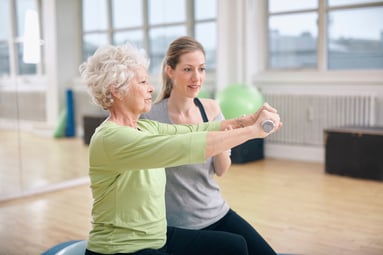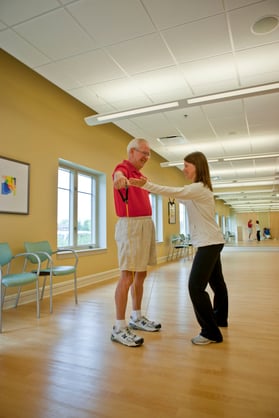What Does Wellness Mean to You?
Wellness might be one of the most overstated and broadly defined terms in the senior living industry—at least in how it is modeled from one community to the next—and it can be exhausting trying to keep up. At community A, wellness might refer to your health service offices, therapy gym, or clinician staff; whereas wellness at community B might refer to your fitness spaces and programming. Neither of those models is wrong. Neither of those models is necessarily correct, either.
.jpg?width=434&name=GettyImages-1161759077%20(1).jpg) When we’re talking about whole-person well-being, it isn’t just the health care options available, or the fitness program offerings. Communities should be cautious about how narrowly they define “wellness” when connecting it to their physical spaces or services. This can have a significant impact in the messaging of your community culture to your residents and prospective residents. Supporting resident well-being should flow through every nook, cranny, department, and service under your roof; however, many communities miss opportunities because they want the word “wellness” labeled on a space or department.
When we’re talking about whole-person well-being, it isn’t just the health care options available, or the fitness program offerings. Communities should be cautious about how narrowly they define “wellness” when connecting it to their physical spaces or services. This can have a significant impact in the messaging of your community culture to your residents and prospective residents. Supporting resident well-being should flow through every nook, cranny, department, and service under your roof; however, many communities miss opportunities because they want the word “wellness” labeled on a space or department.
Wellness Branding Barriers
Here are some remarks I’ve heard from communities through our consulting work, where they have unknowingly created barriers for themselves.
We can’t brand our lifestyle and wellness offerings because…
- “We call our clinic our Wellness Center, and it will confuse residents.”
You are right. If you want to put emphasis on sick care as opposed to preventative lifestyle offerings, this would cause confusion. - “We call our fitness room our Wellness Center, and it will confuse residents.”
Once again, you are right. This sends the message to residents that the only space to support their well-being is associated with physical exercise. - “Our monthly “wellness newsletter” promotes our fitness offerings.”
Once again, your communication channels with residents and how you promote monthly activities carry a connotation.
Slapping the term wellness on physical spaces, services, and communication channels narrows the potential, perspective, and understanding of how your community creates purpose and intention in resident lives. It also perpetuates the silos for staff and departments who have a stake in resident well-being, keeping them from seeing the potential of how their buy-in and collaboration can make an impact. (We’ll talk more about that collaboration piece in part 3 of this blog series.)
Questions for Starting a Wellness Branding Dialogue
Ask yourself these three questions as a guide in sparking dialogue in your community:
- What person, space, or services would come to mind for our residents if we use the word wellness?
- Does this connotation of wellness create opportunity for a broad application of purposeful lifestyle choices that spans the interests and passions of all residents?
- What barriers can we identify that limit our potential for broadening that definition of wellness?
Identifying your current model and barriers is your first step in making positive change toward more effectively use that term “wellness” to your community’s advantage. And now that you’ve defined and branded wellness, part 2 of this series talks about the importance of designating a staff wellness champion for your community.
Wellness Consulting from NIFS
Need some support? NIFS provides wellness consulting to senior living communities across the US. Visit our website and download the “What to Expect from a NIFS Consulting Visit” for more information.




 In the fitness and health field, we are asked for advice continually. It is our job to build fitness routines that are safe, comfortable, and something our clients will actually build into an overall resident wellness lifestyle. The difficult part always seems to be creating a program that they like that also fits around all contraindications of diseases and ailments, and having them not give up after a week.
In the fitness and health field, we are asked for advice continually. It is our job to build fitness routines that are safe, comfortable, and something our clients will actually build into an overall resident wellness lifestyle. The difficult part always seems to be creating a program that they like that also fits around all contraindications of diseases and ailments, and having them not give up after a week.